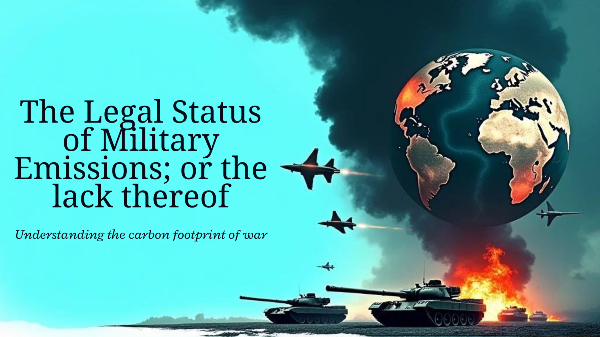Introduction
Although not currently accounted for under the current legal framework, military emissions are estimated to have the fourth-highest carbon footprint. A report by the ‘Initiative on Greenhouse Gas (GHG) Accounting of War’ on the Russia-Ukraine war concluded that during the first 18 months of armed confrontation, 150 million tCO2e were emitted, a figure that, if compared with the GHG emissions of European countries, is more than the annual emissions of an industrialised country like Belgium.
Another study exploring the impacts of Israel's genocide on Gaza found that, as of May 2025, GHG emissions exceed the combined 2023 annual emissions of Costa Rica and Estonia. There is limited information on the exact emissions resulting from ongoing conflicts in Sudan, Congo and other nations, but the devastating impact that armed conflicts have had on the global atmosphere is clear. This article begins by introducing the concept of 'military emissions' and laying out the existing legal framework. It then turns its attention to the advisory proceedings held in December 2024 and the bold assertions made by States from the Global South, before moving into an analysis of the 2025 Opinion and the limited function of the Court in the face of an existential crisis of unparalleled proportions.
Military Emissions
'Military emissions' here refers to GHG emitted by: (1) the fighting activities during armed conflicts (international and non-international, including occupations), (2) the arm industry and the military supply chains, and (3) the collateral consequences of armed conflicts, such as the carbon footprint of forced displaced civilians and refugees, among many other sources.
The Current Framework
International climate change law is primarily based on three international treaties: (1) the 1992 United Nations Framework Convention on Climate Change (UNFCCC); (2) the 1997 Kyoto Protocol; and (3) the 2015 Paris Agreement. Historically, military emissions were exempt from reporting under the Kyoto Protocol, and are currently left to the States' discretion under the Paris Agreement. Under the 2022 Principles on the Protection of the Environment about Armed Conflicts, the UN proposed that the environment be protected during three crucial phases: before, during and after an armed conflict to prevent, mitigate and remediate environmental harm.
Teamwork ICJ and Other Actors:
The ICJ opinion, hailed as a historic overall victory for nations most vulnerable to climate change, was noticeably silent on the issue of military emissions, likely as an exercise of judicial caution in the face of a politically sensitive subject. Even the advisory period held in December 2024 did not see this issue being tabled as a common agenda, but a bold few acknowledged the harm that war itself contributes to the environment; amongst them were Colombia, the Democratic Republic of Congo (DRC), and Palestine. Notably, Palestine had the most comprehensive argument on the binding obligations international law imposes on States to prevent harm to the environment from GHG emissions, including those resulting from armed conflict and military activities. Palestine called on the ICJ to recognise the environment as a civilian object under IHL; asserted that military emissions should be included in States' reporting obligation under the UNFCCC; and contended that States failing to exert appropriate levels of due diligence to control GHG emissions during armed conflict should be held internationally responsible.
Although the ICJ did not directly touch upon military emissions, the 2025 Opinion arguably has some potential to be interpreted as alluding to it. Specifically, it recognised that the rules of IHL may also be relevant in climate change and that it would consider 'the full range of human activities that contribute to climate change as a result of the emissions of GHGs'. This is complemented by the ICJ's discussions of the les specialis which confirmed that the applicability of rules from one legal regime does not necessarily displace rules of another, unless displacement is expressly intended or the two are incompatible. This implies that climate change obligations continue to apply during armed conflicts unless incompatible with IHL rules.
The Way Forward
While a more clarifying answer would have been welcome, the ICJ acknowledged its constraints and emphasised the need for contributions from 'all fields of human knowledge, whether law, science, economics or any other'. This is especially seen in the inclusion of paragraph 456 in the shortened version of the ruling read out by ICJ President Iwasawa Yuji (at 1:50:54), where he highlights the climate crisis as an 'existential problem of planetary proportions that imperils all forms of life'.
